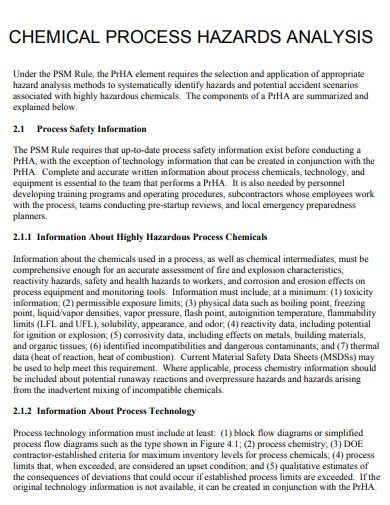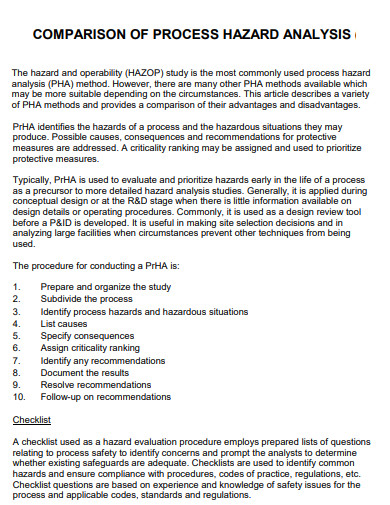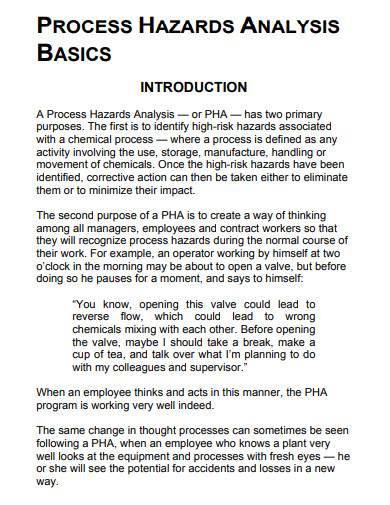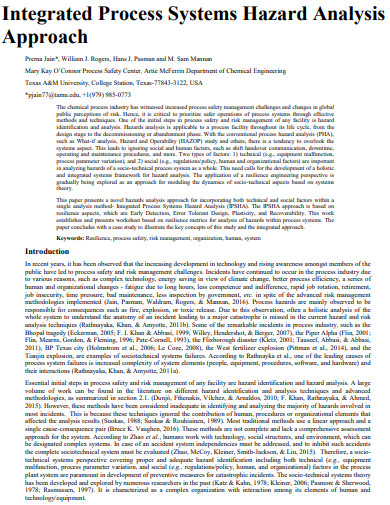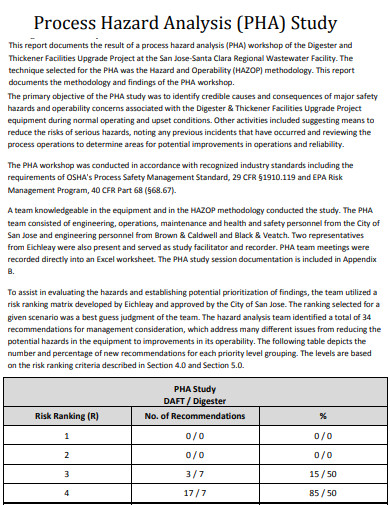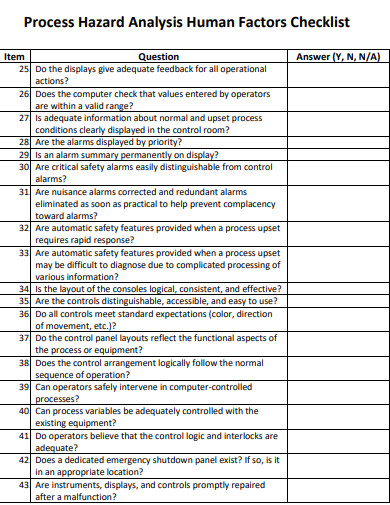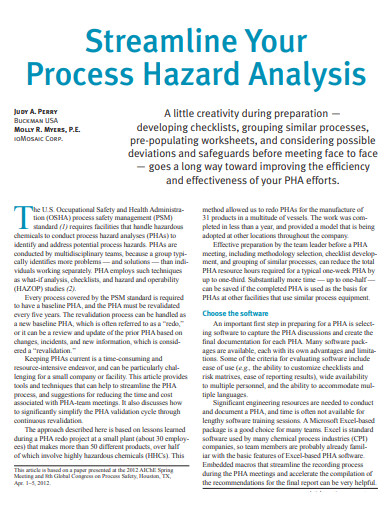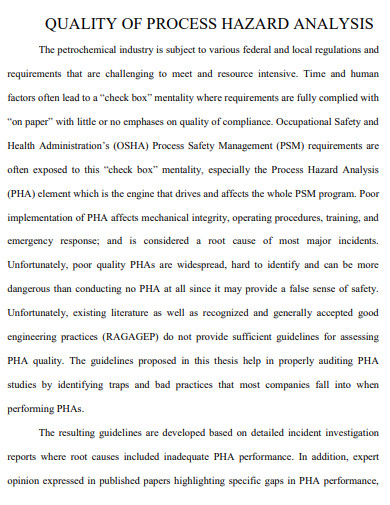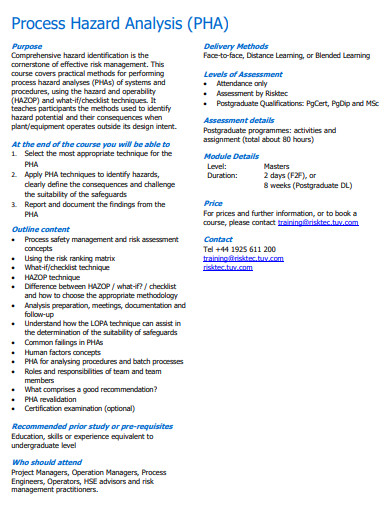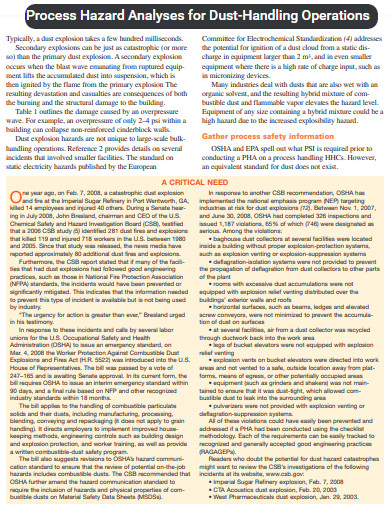Industries with high risks such as chemical and manufacturing companies are strictly required to comply with safety rules and regulations to prevent Major Accident Hazards (MAH) such as explosions, toxic chemical releases, and fires. There are specific steps that these companies can follow to address MAH threats and reduce the risk of serious incidents as a part of their comprehensive process safety management plan or program as well as strategic planning to ensure the safety of every employee. One of the fundamental elements of this program is the process hazard analysis.
10+ Process Hazard Analysis Samples
1. Process Hazard Analysis
2. Chemical Process Hazard Analysis
3. Comparision of Process Hazard Analysis
4. Basics Process Hazard Analysis
5. Integrated Process Systems Hazard Analysis
6. Process Hazard Analysis Study
7. Process Hazard Analysis Checklist
8. Streamline Process Hazard Analysis
9. Quality of Process Hazard Analysis
10. Simple Process Hazard Analysis
11. Process Hazard Analyses for Dust-Handling Operations
What is a Process Hazard Analysis?
Process hazard analysis is a comprehensive and methodological review or evaluation of chemical and manufacturing plant operating procedures that aim to determine possible causes and analyze the effects of hazardous chemical releases. This process enables chemical and manufacturing companies to identify a range of risks from equipment malfunctions to human mistakes to developing safety measures, preventing downtime, and protecting the environment. It involves techniques in evaluating and controlling hazards and risk levels to operating procedures and assessing the effectiveness of existing safety measures and determining whether the company requires additional measures or not.
How to Perform a Process Hazard Analysis
Like other processes, process hazard analysis also follows a written policy and procedure as a part of the company policy for managing the major hazards. The process must be communicated across the company, readily available and accessible to team members, and incorporated into the company’s policy and procedures. Process hazard analysis enables employers and employees to identify and perform data analysis, allowing them to improve their safety measures and reduce the possibility of an unplanned release of hazardous chemicals.
Step 1: Determine the Tasks Needed to be Accomplished to Realize Your Goals
Hazard analysis aims to determine ways to lessen the possibility of injury, loss, or harm while team members are working on their projects to achieve their company or business goals. You can use a hazard identification checklist to identify hazards that come with tasks.
Step 2: Identify Hazards Associated with Executing These Tasks
The checklist mentioned in the first step contains the nine basic hazard categories with concise descriptions of each hazard that you might encounter while performing your tasks.
Step 3: Create a List of Controls
Include a list of controls to ensure that the possibility of accidental contact with unsecured equipment is minimized or eliminated. The list can include the security of workpieces during procedures, training of the employee before performing the task and making sure that they are properly wearing protective clothing.
Step 4: Provide a Safe Working Procedure
Use the hazard identification checklist to draft or write appropriate safe working or operating procedures. It should contain the identified hazards and risks that come with the tasks being performed.
FAQs
What are the other safety resources to be consulted when performing a hazard analysis?
When performing a hazard analysis, you should consult the MTU office of Environmental Health and Safety, safety officers related to sponsoring companies, MIOSHA regulations, NIOSH recommendations, safety publications, equipment and tool operating manuals, and safety data sheets for chemicals and other hazardous materials.
What should the PHA policy and procedure include?
The policy and procedure for a PHA process define the objectives for performing PHA, its scope of work, techniques to be used, key roles and responsibilities as well as competence requirements of all people involved, schedule or time management, required documentation, the required definition, and the key steps in the process.
What are the benefits of process hazard analysis?
With process hazard analysis, you can identify the sources of errors and estimate the possibilities of their occurrence, comply with safety regulations, and implement internal workshops to train and educate employees on how to effectively manage risks.
Process hazard analysis is a structured method used by high-risk industries to effectively approach and manage chemical process operations, enabling them to understand and be informed of the possible risks and hazards in their operational procedures. The absence or ineffective implementation of a process hazard analysis can lead to an increase in overall risk levels within the company or organization.
Related Posts
What Is Business Analysis? [ Types, Steps, How to Write ]
FREE 9+ Sample Job Analysis Templates in MS Word PDF ...
FREE 10+ Quantitative Risk Assessment Samples in PDF DOC
FREE 10+ Qualitative Risk Assessment Samples in PDF DOC
FREE 10+ Hazard Assessment Checklist Samples [ Fall ...
FREE 8+ Value Analysis Samples in PDF MS Word
FREE 10+ Environmental Risk Assessment Samples [ Health, Social ...
FREE 7+ Sample Job Safety Analysis Templates in Excel PDF ...
FREE 10+ Risk Assessment Method Statement Samples in PDF
FREE 10+ Accident and Incident Report Samples in MS Word ...
FREE 12+ Team Analysis Samples in PDF MS Word
FREE 10+ Decision Matrix Samples in MS Word PDF | DOC
FREE 5+ Post-Security Incident Report Samples in PDF
FREE 10+ Data Analysis Plan Samples [ Collection, Project ...
FREE 25+ Sample Gap Analysis Templates in PDF Excel | MS ...


